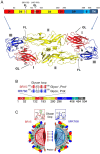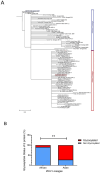The Evolving Role of Zika Virus Envelope Protein in Viral Entry and Pathogenesis
- PMID: 40573410
- PMCID: PMC12197574
- DOI: 10.3390/v17060817
The Evolving Role of Zika Virus Envelope Protein in Viral Entry and Pathogenesis
Abstract
Zika virus (ZIKV) was first discovered in Uganda's Zika Forest in 1947. The early African viruses posed little or no health risk to humans. Since then, ZIKV has undergone extensive genetic evolution and adapted to humans, and it now causes a range of human diseases, including neurologically related diseases in adults and congenital malformations such as microcephaly in newborns. This raises a critical question as to why ZIKV has become pathogenic to humans, and what virological changes have taken place and enabled it to cause these diseases? This review aims to address these questions. Specifically, we focus on the ZIKV envelope (E) protein, which is essential for initiating infection and plays a crucial role in viral entry. We compare various virologic attributes of E protein between the ancestral African strains, which presumably did not cause human diseases, with epidemic strains responsible for current human pathogenesis. First, we review the role of the ZIKV E protein in viral entry and endocytosis during the viral life cycle. We will then examine how the E protein interacts with host immune responses and evades host antiviral responses. Additionally, we will analyze key differences in the sequence, structure, and post-translational modifications between African and Asian lineages, and discuss their potential impacts on viral infection and pathogenesis. Finally, we will evaluate neutralizing antibodies, small molecule inhibitors, and natural compounds that target the E protein. This will provide insights into the development of potential vaccines and antiviral therapies to prevent or treat ZIKV infections and associated diseases.
Keywords: African and Asian lineages; Zika virus; ancestral and epidemic viral strains; antibody-dependent enhancement; envelope protein; inhibitors; microcephaly; neutralizing antibodies; viral entry.
Conflict of interest statement
The authors declare that there is no conflict of interest of any kind. The opinions expressed by the authors contributing to this journal do not necessarily reflect the opinions of the institutions with which the authors are affiliated.
Figures




References
-
- Dick G.W., Kitchen S.F., Haddow A.J. Zika Virus: A New Virus Isolated from Aedes mosquitoes in Uganda. Nature. 1952;229:735–736.
Publication types
MeSH terms
Substances
Associated data
- Actions
- Actions
Grants and funding
LinkOut - more resources
Full Text Sources
Medical

